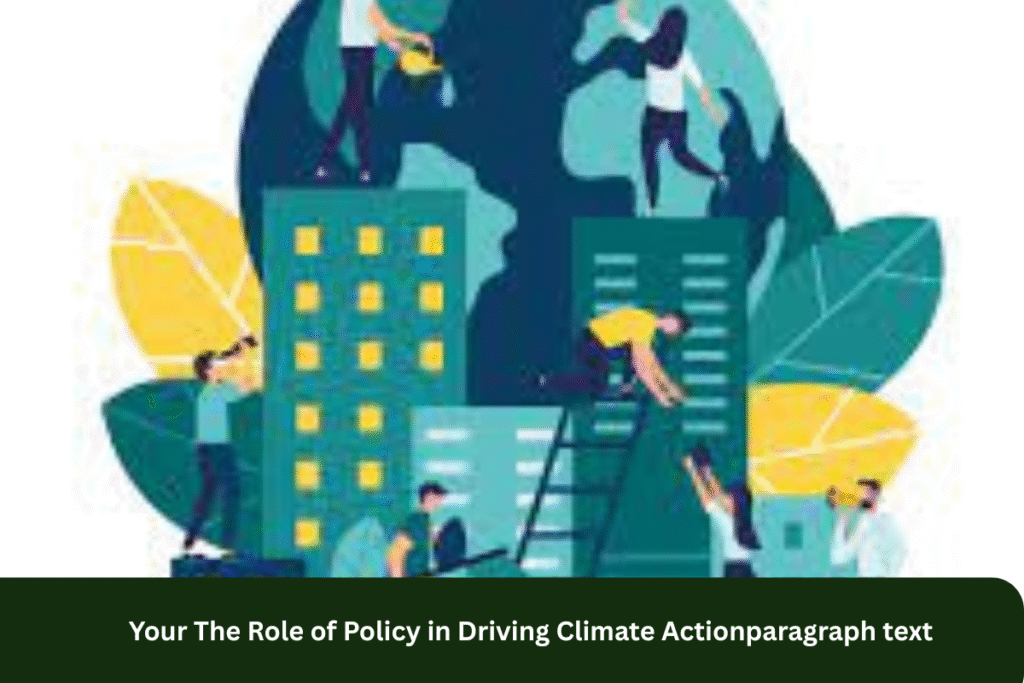
As the world faces the growing threat of climate change, the importance of effective policy in driving climate action has never been more evident. Governments, international organizations, and policymakers play a critical role in shaping the trajectory of climate change mitigation and adaptation efforts. Policy decisions can help reduce greenhouse gas emissions, promote the transition to renewable energy, protect vulnerable communities, and create sustainable development pathways. In this article, we will explore the role of policy in driving climate action, the key areas where policy can make an impact, and how effective climate policies can help mitigate the effects of global warming.
1. Why is Policy Important in Climate Action?
Climate change is a global challenge that requires coordinated efforts across countries, sectors, and communities. While individual actions are important, effective climate action requires systemic changes that can only be achieved through robust policy frameworks. Policies provide the structure and incentives needed to drive large-scale shifts toward sustainability, including reducing carbon emissions, transitioning to clean energy, and promoting climate resilience.
Climate policies create the conditions for change by:
- Setting clear targets and timelines: Governments can establish legally binding emissions reduction targets, which help ensure that climate action remains a priority.
- Allocating financial resources: Climate policies can direct funds toward renewable energy, green infrastructure, and other climate initiatives.
- Creating incentives for innovation: Well-designed policies can encourage businesses to invest in clean technologies and sustainable practices.
- Establishing regulations and standards: Policymakers can implement environmental regulations, such as emissions standards, that require industries to reduce their environmental footprint.
In short, policy provides the framework for climate action and enables meaningful change at the local, national, and global levels.
2. Key Areas Where Policy Drives Climate Action
There are several key areas where effective policy can accelerate progress toward mitigating climate change and building resilience. These areas include:
a. Setting Emissions Reduction Targets
One of the primary roles of policy in climate action is to set clear and measurable emissions reduction targets. International agreements like the Paris Agreement have been instrumental in setting global goals for limiting global warming. However, each country must translate these global targets into national policies and actions. For example:
- Carbon Pricing: Policies like carbon taxes and cap-and-trade systems put a price on carbon emissions, incentivizing industries to reduce their carbon footprint.
- Emission Reduction Plans: Governments can implement sector-specific action plans that focus on reducing emissions in industries such as transportation, agriculture, and manufacturing.
b. Promoting Renewable Energy and Clean Technologies
Transitioning to renewable energy sources is essential for reducing global emissions. Policy plays a crucial role in supporting this transition by:
- Subsidizing Renewable Energy: Governments can provide financial incentives, subsidies, or tax credits for the development and deployment of renewable energy technologies, such as solar, wind, and hydropower.
- Investing in Research and Development: Policies that support innovation in clean technologies—such as energy storage, electric vehicles, and carbon capture—can accelerate the transition to a low-carbon economy.
- Renewable Energy Standards: Policymakers can set renewable energy targets for utilities and companies, pushing for greater adoption of clean energy.
c. Carbon Pricing and Market-Based Solutions
Carbon pricing is one of the most powerful tools for driving climate action. By putting a price on carbon emissions, carbon pricing policies create economic incentives for businesses to reduce their greenhouse gas emissions. Carbon pricing can take two forms:
- Carbon Tax: A direct tax on the carbon content of fossil fuels, which encourages businesses and consumers to reduce their carbon footprint by choosing cleaner energy options.
- Cap-and-Trade: A system that sets a limit (cap) on total emissions and allows businesses to buy and sell emission allowances. This creates a market for carbon reductions and encourages companies to innovate in reducing emissions.
d. Adaptation and Resilience Policies
While reducing emissions is critical, adaptation to the inevitable impacts of climate change is equally important. Climate policies must address resilience and adaptation by:
- Investing in Infrastructure: Governments can fund the construction of climate-resilient infrastructure, such as flood barriers, drought-resistant crops, and improved water management systems.
- Protecting Vulnerable Communities: Policymakers can implement social protection programs, build disaster response capacity, and support the relocation of communities at risk from climate impacts.
- Ecosystem Restoration: Policies that support the restoration of forests, wetlands, and coastal ecosystems help protect communities from extreme weather events and provide natural solutions to climate adaptation.
e. International Cooperation and Climate Finance
Climate change is a global challenge that requires global solutions. International cooperation is vital to addressing the impacts of climate change, particularly in developing countries that lack the resources to mitigate and adapt to climate impacts. Policies in this area include:
- Climate Finance: Developed nations can provide financial assistance to developing countries to help them reduce emissions and build climate resilience.
- Technology Transfer: International policies can facilitate the transfer of clean technologies to developing countries, helping them leapfrog to low-carbon economies.
3. The Role of Policy in Achieving the Paris Agreement Goals
The Paris Agreement—adopted by nearly 200 countries in 2015—set a global goal to limit global warming to well below 2°C, ideally to 1.5°C, compared to pre-industrial levels. Achieving this goal will require robust climate policies at both national and international levels. Policymakers play a critical role in ensuring that countries meet their commitments by:
- Aligning national policies with global targets: Governments must develop and implement policies that contribute to the global goal of reducing emissions.
- Monitoring progress and adjusting policies: Policymakers must regularly assess progress toward climate targets and make adjustments to policies as needed.
- Enhancing international cooperation: Strong international policies that promote cooperation on climate action are essential for meeting the ambitious targets of the Paris Agreement.
4. FAQs
1. Why is policy important for climate action?
2. What are some examples of climate policies?
3. How can policies help reduce emissions?
4. What is the Paris Agreement, and how does policy support it?
5. How can policies help vulnerable communities adapt to climate change?
5. Conclusion
The role of policy in driving climate action is critical for ensuring a sustainable future. Effective climate policies can accelerate the transition to a low-carbon economy, reduce emissions, support adaptation efforts, and address climate justice. Governments and international organizations must work together to create a policy framework that promotes environmental sustainability, economic development, and social equity. By implementing strong policies, we can collectively achieve the global climate goals set by the Paris Agreement and mitigate the impacts of climate change for generations to come.
